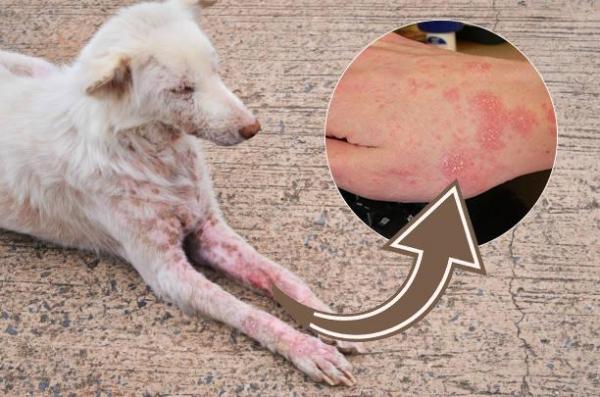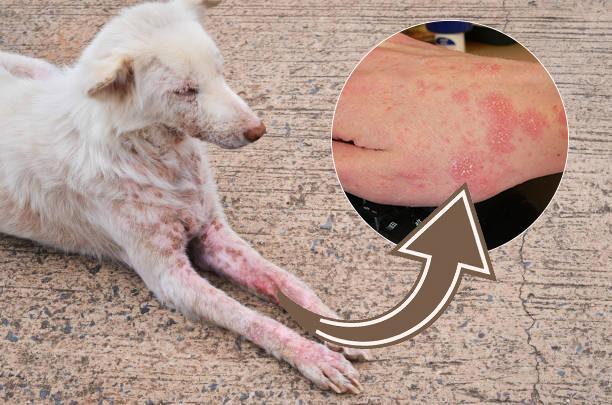Dog Diseases Transmitted to Humans



See files for Dogs
There are many diseases unique to the animal world which cannot be transmitted to human beings. We can spend time with a dog affected by such a disease and not worry about getting sick ourselves. There are also many diseases which have both human and canine forms, but which cannot pass between species. A good example of this is influenza. A dog cannot get the flu from a human and vice versa. Those that remain are known as canine zoonotic diseases. These are diseases which can pass from a dog to a human.
At AnimalWised, we share the dog diseases transmitted to humans. Knowing these zoonotic diseases and how to limit contagion protects the health of the human members of our family, while best meeting the health needs of our beloved canine companions.
Intestinal parasites in dogs transmitted to humans
Not all internal parasites in dogs are zoonotic. Many infestations will not cross the species barrier, but there are some which can. The majority of these are intestinal parasites which result in gastrointestinal disorders. They can also include parasites such as heartworm which we will discuss in the next section. Intestinal parasites which can be transmitted from dogs to humans include:
- Roundworm: nematodes (the scientific name for roundworm) are one of the most widespread parasites in dogs. Contagion is made possible through the placenta or breast milk of a mother dog to their young, as well as being ingested from the ground or an infested animal carcass. These parasites do no usually produce symptoms in healthy animals, but can cause vomiting and diarrhea in younger or more vulnerable dogs or puppies. In humans this zoonotic disease is responsible for a disorder known as visceral larva migrans.
- Giardia: an infestation of giardia is due to protozoa responsible for symptoms such as profuse diarrhea. As always, an infestation will have a much greater impact on vulnerable animals such as those with a weakened immune system. It is believed that some genotypes are able to infest humans, although the most common cause in humans is due to contaminated water. Giardia is not always detected by examining a single stool sample, as excretion of them is intermittent. Samples need to be taken over a few days.
- Tapeworms: there are many different varieties of tapeworm such as those from the genera Dipylidium or Echinococcus. Fleas can transmit them to our dogs and they are then passed on to us. Children may become infected if they ingest flea eggs directly, often from eating something they shouldn't. Infestation can come from ingesting eggs found in contaminated food, water or materials in a dog's environment. Taeniasis is a parasitic disease caused by infection of tapeworms and it can be asymptomatic. We may sometimes see proglottids around the anus area of the dog. These are broken segments of the tapeworm itself which look a lot like little grains of rice and often cause irritation. Echinococcosis is more common in dogs, but is rare in humans. If it is contracted by humans, it can result in hydatid cysts in the liver, lungs and brain.
The transmission of parasites from dogs to humans can occur in different ways. One of the most common is when the animal sniffs infested stool or other material, licks our hands and then we transfer it to our own mouths. If a dog infested with parasites defecates in the home or garden and the stool is left for some time, transmission can be made if we don't take the correct hygiene precautions. The same can happen when we take our dogs outside and they come in contact with infested material. In general, young children are most susceptible because they often put things in their mouths which they should not.
An up to date internal and external deworming schedule is the best way we can prevent infestation of these intestinal parasites. This is especially the case in vulnerable animals such as puppies. Because we love our dogs and want what's best for them, we need to take our dog to the vet to see what is the best deworming schedule in your area.

Filariasis (heartworm)
Among communicable diseases between dogs and humans, we now highlight one which is becoming increasingly more important. Filariasis is a parasitic disease caused by a roundworm infection. One particular type of canine roundworm called Dirofilaria immitis is known as heartworm. It is particularly dangerous as it can result in acute heart failure. The vector of this zoonotic disease is the mosquito which transmits the heartworm eggs through its buccal (mouth) organs. This means a dog can become infested via a mosquito bite.
The filaria eggs will go through different stages of maturation until they end up lodging in the pulmonary arteries, right side of the heart, venae cavae or hepatic veins. Additionally, females release microfilariae into the blood which can be passed on to another mosquito through a bite. This mosquito can then go on to infect more dogs.
As we can see, it is not possible for the dog to directly infect humans with the disease. However, we can become infested if the mosquito bites the dog and then transfers it to us. The dog acts as a reservoir for the disease. It is still relatively uncommon in humans and when it does occur, it can be asymptomatic. However, heartworm can have dire consequences in dogs. This is because they can cause great damage to fundamental organs such as the heart, lungs or liver, often resulting in death.
Infestation affecting the aforementioned vital organs in this way complicates treatment, especially when the worms are adult. Once again, this makes prevention so imperative. Finding out about your local mosquito rates and using protection against them is a good start. You need to establish general guidelines which limit the exposure of your dog to potentially infectious insects. Internal anti-parasitic drugs will also help to prevent the heartworm from completing their growth cycle.
Deworming the dog is important everywhere, but it takes on extra gravity when you live in an area where the disease is endemic. You will need to speak to your veterinarian to establish a suitable deworming schedule for the parasites most common to your area.
Skin diseases dogs can transmit to people
Scabies and ringworm are the most common skin diseases a dog can pass on to people. Both are well-known conditions and have fairly obvious symptoms. Their characteristics include:
- Ringworm: also known as dermatophytosis, this zoonotic disease is caused by a fungus (not an actual worm) which leads to circular patches on the skin. Spores from this fungus make their way into a shared environment, infecting other dogs, other animals and even humans.
- Scabies: this is caused by a mite which burrows into the skin producing pruritus (pus). Skin lesions develop into wounds and cause alopecia. When the mite is in the environment, it can be very contagious especially with young or immunosuppressed dogs. Not all types of scabies are considered zoonoses. The most common one in dogs is known as sarcoptic mange and is cause by the mite Sarcoptes scabiei.
Preventing these diseases most commonly involves hygiene. Disinfection and regular washing of bedding and other material which comes in contact with the dog is vital. It is also important to keep the dog under close observation and take it to the veterinarian when you see any initial symptoms.
Discover more about scabies in dogs with our related guide.

Rabies
Although the disease is practically eradicated in certain parts of the world such as Western Europe and North America, it is important to have it on this list of zoonotic diseases between dogs and humans. It still causes numerous human deaths in other parts of the world such as Asia and Africa. In Central and South America, we can find high risk regions as well as those which have long established vaccination programs, making cases less likely.
Rabies is a viral disease which affects the brain. There is a vaccine which is the only way to fight it, both in terms of prevention and treatment. Rabies affects the central nervous system and is fatal once symptoms appear. It is transmitted through saliva, so is passed on from dogs to humans through bites. It makes an infected dog very aggressive in its latter stages, greatly increasing the likelihood of transmission.
If the anti-rabies medication is not given before the viral infection reaches the brain, the person or dog will die. This is why immediate action is so necessary.

Other diseases dogs can transmit to people
In addition to the above communicable diseases from dogs to humans, people can also contract diseases such as leishmaniasis or leptospirosis from dogs. Below we explain how:
Leishmaniasis in dogs and humans
This parasitic disease has considerable scope, hence its inclusion on this list. As with dirofilariasis, the dog dos not infect humans directly, but acts as a reservoir for the disease which is transmitted by mosquito bites.
The symptoms are varied as it is divided into different types, but they all will form some sort of skin lesion such as sores or ulcers. Treatment is essential as some forms of leishmaniasis can be fatal if left untreated. Vaccination against the disease is available, but prevention is the most important method of treatment.
Leptospirosis in dogs and humans
After reviewing the main pathologies which can be passed on from dogs to people, we end with leptospirosis. This is a bacterial disease for which there is no vaccine. The symptoms it produces are varied and can affect the digestive system, the liver or kidneys. The bacteria spreads through the urine of dogs and can remain in the ground for a period of months.
Both other dogs and humans can be infected by coming in contact with leptospirosis bacteria. Infected material can also get into the body through an open wound or by drinking contaminated water. This disease requires veterinary treatment.
External parasites transmitted from dogs to humans
Fleas, ticks and lice are all parasites which can easily transfer from a dog's skin to our own. Although a change of host does not necessarily constitute the spread of disease, these parasites can pass on disease through their bites, eggs and droppings. Such disease may be some of the ones written about above, but they can also pass on diseases such as Lyme disease.
In general, these external parasites can lead to symptoms such as itching, rashes, open sores and even gastrointestinal problems. To avoid a possible infestation, we need to ensure the hygiene of our home and perform regular examinations of our dogs, especially if they have been somewhere where these parasites are likely to inhabit.

How to stop zoonotic diseases in dogs
As we have seen, there are many diseases, infections, parasites and conditions which can be transmitted from canines to humans. To best prevent this from happening, there are some precautionary measures you can take:
- Internal and external deworming with regular boosters and knowing the particular hazards in your area.
- Maintaining an appropriate vaccination schedule.
- Avoiding walking during times when mosquitoes are most prevalent.
- Regularly cleaning and disinfecting the places our dog likes to spend their time, especially if we have more than one.
- Washing our hands when we touch our dog and their toys, especially if we are eating. You have to be careful with children in particular when they handle dogs.
- Going to the veterinarian for regular check ups.
To learn more, take a look at our video on diseases dogs can transmit to humans which we share below:

This article is purely informative. AnimalWised does not have the authority to prescribe any veterinary treatment or create a diagnosis. We invite you to take your pet to the veterinarian if they are suffering from any condition or pain.
If you want to read similar articles to Dog Diseases Transmitted to Humans, we recommend you visit our Prevention category.









